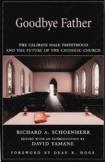Stretch the Envelope, Please
This book, like Richard Schoenherr’s Full Pews and Empty Altars (1993), will be controversial. His earlier work was a demographic study that identified the magnitude of the priest shortage and made projections about future trends. Since the news was not good, some criticized his findings and others his motives. Yet the book was praised by many, and, in time, his projections have proven to be largely accurate. In 1996, before he had a chance to have this new volume published, Schoenherr died unexpectedly, leaving a 1,200-page manuscript—described as his “magnum opus.” His former student, David Yamane (assistant professor of sociology at the University of Notre Dame), has done a masterful job of condensing the work to a readable 250 pages. He also provides a useful introduction updating some of the material related to the work completed by Schoenherr in 1995.
The main thesis of Goodbye Father: The Celibate Male Priesthood and the Future of the Catholic Church is that since the ordained priesthood is absolutely essential to the Roman Catholic Church, the present shortage of priests must be dealt with by not limiting ordination exclusively to celibate males. Obviously, the notion of expanding who can be ordained will be the source of strongly divergent opinions about the book. As the foreword points out, “some Catholic leaders see purple and close their ears to anything Schoenherr has to say,” both because of his message and because he resigned from the priesthood to get married. But the book concerns much more than an argument about who should be ordained; his significant scholarly reflections on the interplay between religion and modern society deserve serious study.
The book is structured in five parts. Part One and the last two parts provide an elaboration of Schoenherr’s thesis about the priest shortage and a description of his theories on why changes in ordination requirements are imperative but slow to come. Of the five parts of the book, the scope and depth of the two central parts are the most impressive and potentially most valuable for those who wish to understand the immense and far-reaching changes in the church and the world since the Second Vatican Council. He sets out to explain in great detail the character of organized religion and how social change interacts with religious beliefs to create religious conflict. Exceptional is his analysis of the social conditions that are changing the face of Roman Catholicism and virtually every dimension of ministry. Although the book was written seven years ago, the trends he discusses have only intensified since then. Schoenherr examines in depth the seven trends he believes have created much tension and conflict in the church: the demographic transition, the shift from dogmatism to pluralism, the shift from Western to world church, celibacy and the growing personalism of human sexuality, the feminist movement, the lay movement and the liturgical movement. He describes the structural strain these developments place on the church, especially in relation to the priesthood and, ultimately, on what Schoenherr calls “the survival of the Eucharist, the very capstone of Catholic piety.”
Of particular interest in Schoenherr’s analysis is his discussion of the terms “hierarchy” and “hierophany,” which he relates to the built-in tension of several of these trends. He says that in Roman Catholicism the priest embodies hierarchic power by being chosen and set aside to act in the community’s name. The priest also embodies hierophanic power through ministering the sacraments, especially presiding at the Eucharist. But hierophany—which he defines as the manifestation of the sacred, the holy, the experience of mystical ecstasy—is also embodied in the priesthood of all believers. This profoundly personal religious experience is free, unpredictable and unknowable. In religious power conflicts, many believers reject centralized power in favor of interior personal power. The resulting tension “between hierarchy and hierophany and between ordained priesthood and the priesthood of all believers,” Schoenherr says, “is resolved when, and only when, all members achieve unitive consciousness of Absolute Reality. In that timeless moment, hierarchy dissolves in an ultimate cosmic hierophany and, along with it, all other divisions in the community of believers.”
Until that time of resolution, however, the conflicts brought on by parallel trends in church and society deeply affect the exercise of ordained priesthood and the practices of church members. In the end, Schoenherr believes that if the “charismatic coalition” succeeds, ordination will be expanded beyond celibate males. If it does not succeed, he feels, the church as we know it will no longer exist.
Goodbye Father is not an easy read on several counts. For those who have an aversion to social and organizational theory, the extensive parts of the book devoted to the literature and using the vocabulary of those disciplines may be off-putting, even daunting. Yet for those who take time to appreciate the interpretation of these significant theories, much can be gained. More substantially, the book is not likely to be accepted by anyone who holds as a matter of faith that the requirements for ordination are unchangeable. Schoenherr’s hypothesis that if ordination is reserved exclusively to celibate males, the Eucharist—the foundation of Catholicism—will be threatened, is likely to exacerbate the controversy about the book. The very title, Goodbye Father, would suggest to some “the end of priesthood.” However, the editor notes:
To the contrary, this book is a historical, sociological, and theological defense of the absolute necessity of a professional, hierarchical, ordained priesthood. In this sense, this is a profoundly conservative book. What Goodbye Father does mean is goodbye to the exclusively male, celibate priesthood. In this sense this is a profoundly radical book.
Whether readers find the book profoundly conservative or profoundly radical will depend substantially on their fundamental beliefs about what will help the church to survive and thrive in the challenging years ahead.
This article also appeared in print, under the headline “Stretch the Envelope, Please,” in the November 11, 2002, issue.








